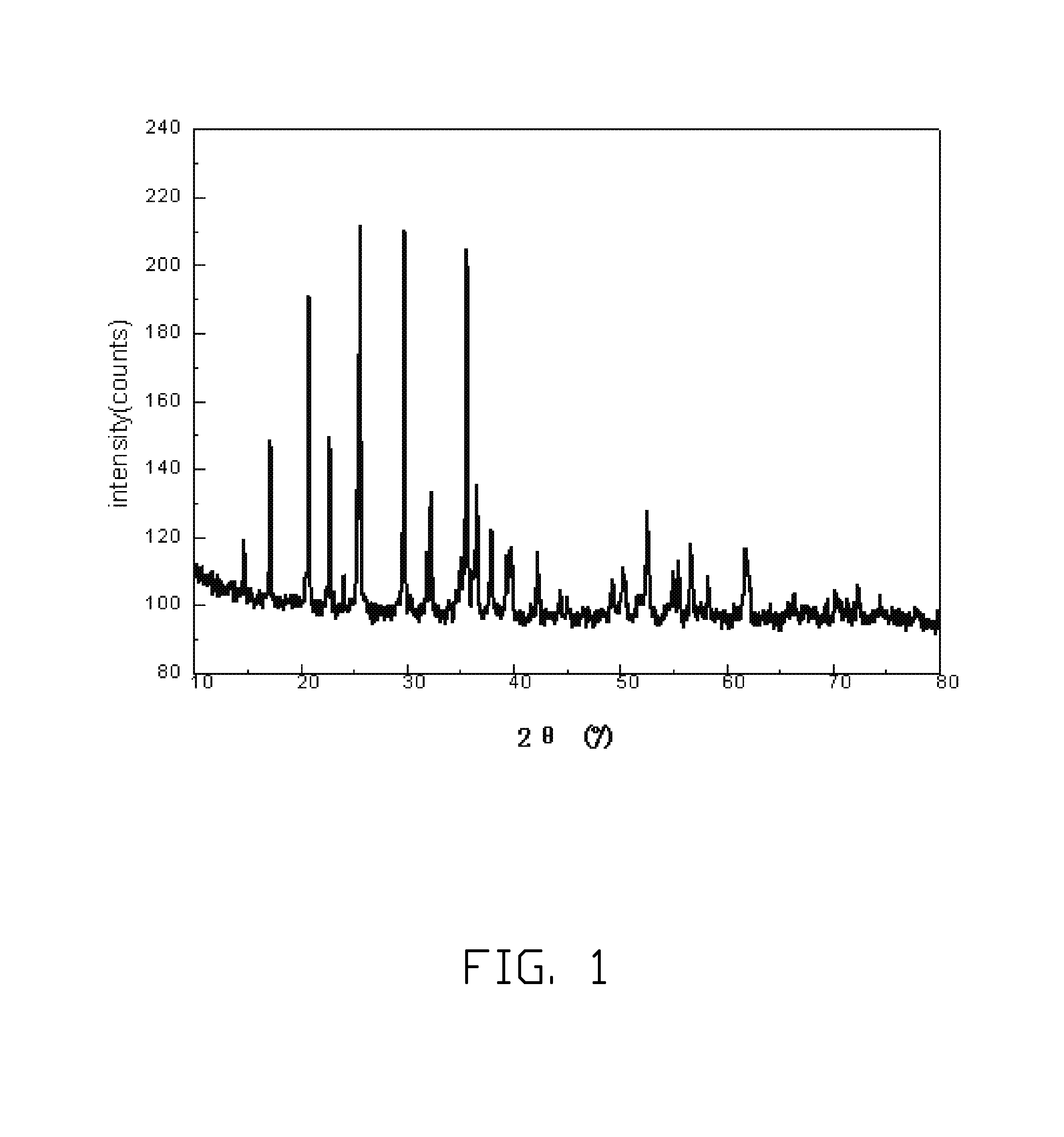Method for making lithium iron phosphate cathode material
a lithium iron phosphate and cathode material technology, applied in the direction of phosphorus oxyacids, chemistry apparatuses and processes, lithium compounds, etc., can solve the problems of large energy consumption, low electronic conductivity and slow diffusion of lithium ions, and deficiencies of lithium iron phospha
- Summary
- Abstract
- Description
- Claims
- Application Information
AI Technical Summary
Benefits of technology
Problems solved by technology
Method used
Image
Examples
example 1
[0026]10 kg of water solution of FeCl3 having the concentration of 5 wt % is put into a reactor and stirred quickly. 7.41 kg of NaOH water solution having the concentration of 5 wt % is dropped slowly to the stirred water solution of FeCl3, to form the red colored Fe(OH)3 precipitate. The red colored Fe(OH)3 precipitate is filtered out and washed for several times until. The formed red colored Fe(OH)3 precipitate is totally put into another reactor followed by adding 1.7 kg of deionized water, 1.7 kg of toluene, and 0.35 g of nonylphenoxypoly(ethyleneoxy)ethanol thereto to form a mixture. The mixture is stirred quickly to form the water-in-oil emulsion. 533.8 g of phosphoric acid solution having the concentration of 85 wt % is added to the water-in-oil emulsion and then the water-in-oil emulsion is heated to about 40° C. and stirred for about 2 hours. Then, 86.4 g of iron metal powder is added to the water-in-oil emulsion, and stirred for about 12 hours. After that, 127.6 g of LiOH ...
example 2
[0028]5 kg of water solution of FeCl3 having the concentration of 30 wt % is put into a reactor and stirred quickly. 5.7 kg of KOH water solution having the concentration of 30 wt % is dropped slowly to the stirred water solution of FeCl3, to form the red colored Fe(OH)3 precipitate. The red colored Fe(OH)3 precipitate is filtered out and washed for several times. The formed red colored Fe(OH)3 precipitate is totally put into another reactor followed by adding 14.8 kg of deionized water, 44.6 kg of chloroform, and 9.9 g of lauryl alcohol thereto to form a mixture. The mixture is stirred quickly to form the water-in-oil emulsion. 1.6 kg of phosphoric acid solution having the concentration of 85 wt % is added to the water-in-oil emulsion and then the water-in-oil emulsion is heated to about 50° C. and stirred for about 8 hours. Then, 259.2 g of iron metal powder is added to the water-in-oil emulsion, and stirred for about 24 hours. After that, 513.9 g of Li2CO3 is added to the water-i...
example 3
[0029]7.46 kg of water solution of Fe(NO3)3 having the concentration of 15 wt % is put into a reactor and stirred quickly. 1.6 kg of ammonia having the concentration of 15 wt % is dropped slowly to the stirred water solution of Fe(NO3)3, to form the red colored Fe(OH)3 precipitate. The red colored Fe(OH)3 precipitate is filtered out and washed for several times. The formed red colored Fe(OH)3 precipitate is totally put into another reactor followed by adding 5 kg of deionized water, 10 kg of nitrobenzene, and 4.5 g of polyacrylamide thereto to form a mixture. The mixture is stirred quickly to form the water-in-oil emulsion. 0.8 kg of phosphoric acid solution having the concentration of 85 wt % is added to the water-in-oil emulsion and then the water-in-oil emulsion is heated to about 45° C. and stirred for about 4 hours. Then, 129.6 g of iron metal powder is added to the water-in-oil emulsion, and stirred for about 16 hours. After that, 270 g of Li2CO3 is added to the water-in-oil e...
PUM
| Property | Measurement | Unit |
|---|---|---|
| temperature | aaaaa | aaaaa |
| temperature | aaaaa | aaaaa |
| time period | aaaaa | aaaaa |
Abstract
Description
Claims
Application Information
 Login to View More
Login to View More - R&D
- Intellectual Property
- Life Sciences
- Materials
- Tech Scout
- Unparalleled Data Quality
- Higher Quality Content
- 60% Fewer Hallucinations
Browse by: Latest US Patents, China's latest patents, Technical Efficacy Thesaurus, Application Domain, Technology Topic, Popular Technical Reports.
© 2025 PatSnap. All rights reserved.Legal|Privacy policy|Modern Slavery Act Transparency Statement|Sitemap|About US| Contact US: help@patsnap.com


